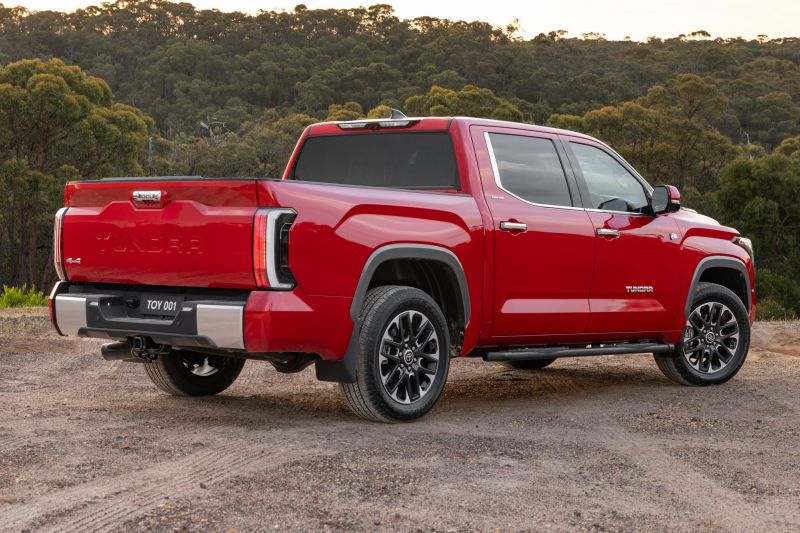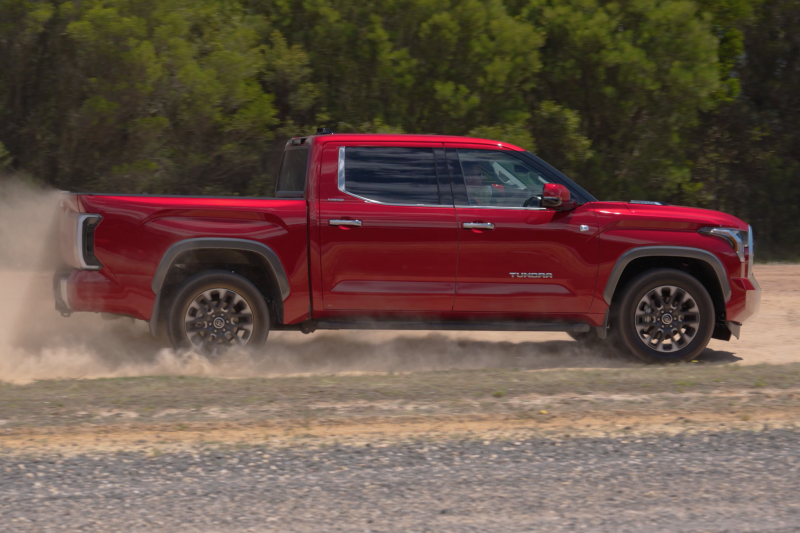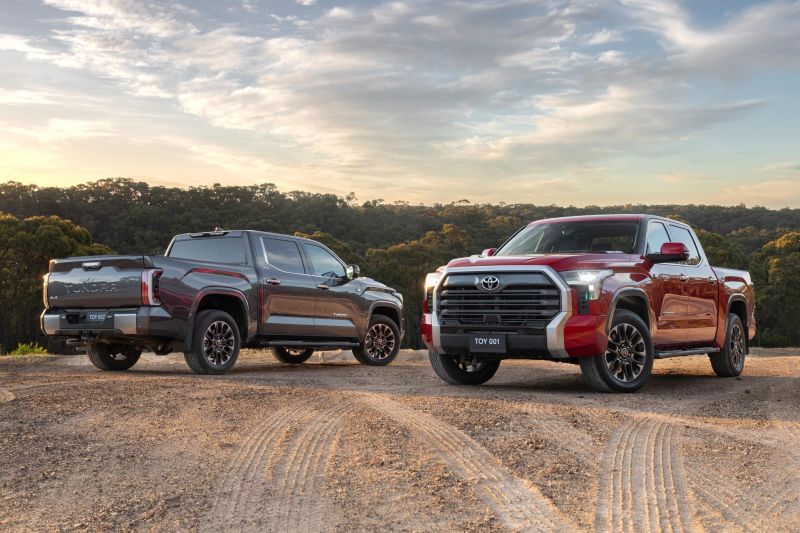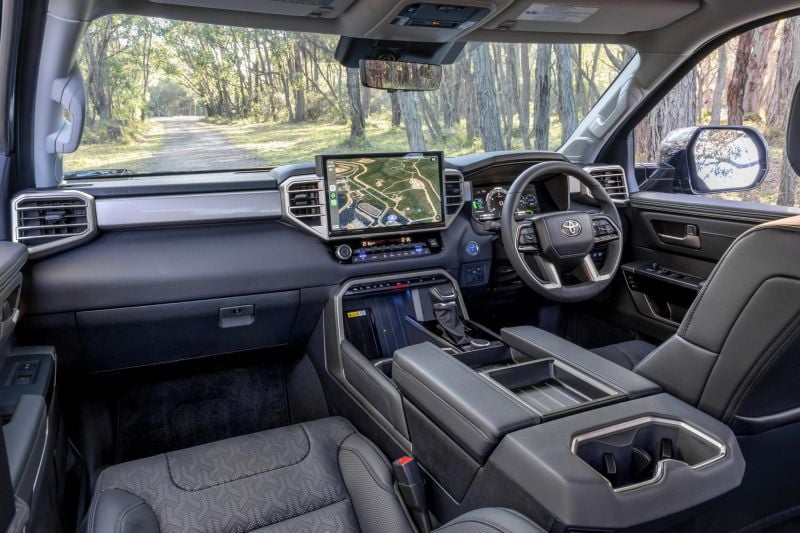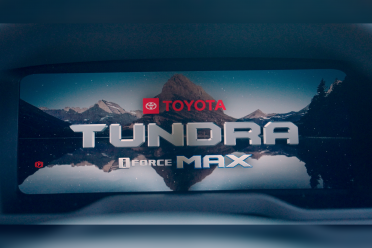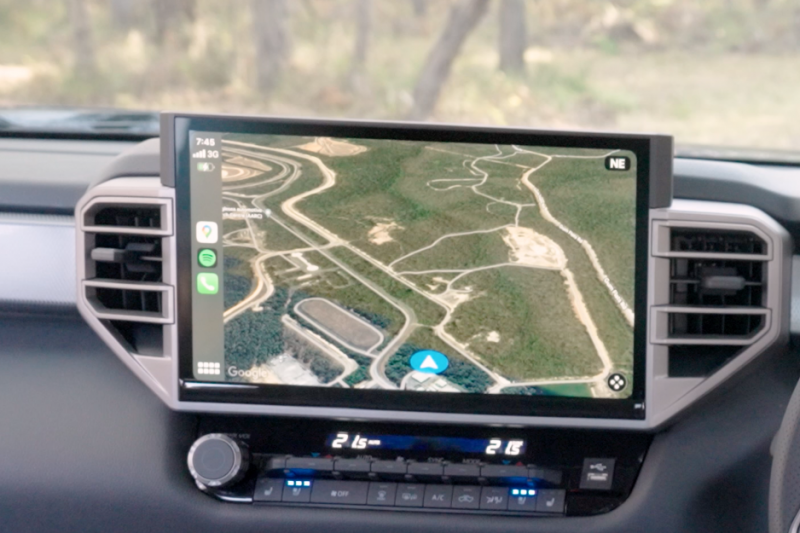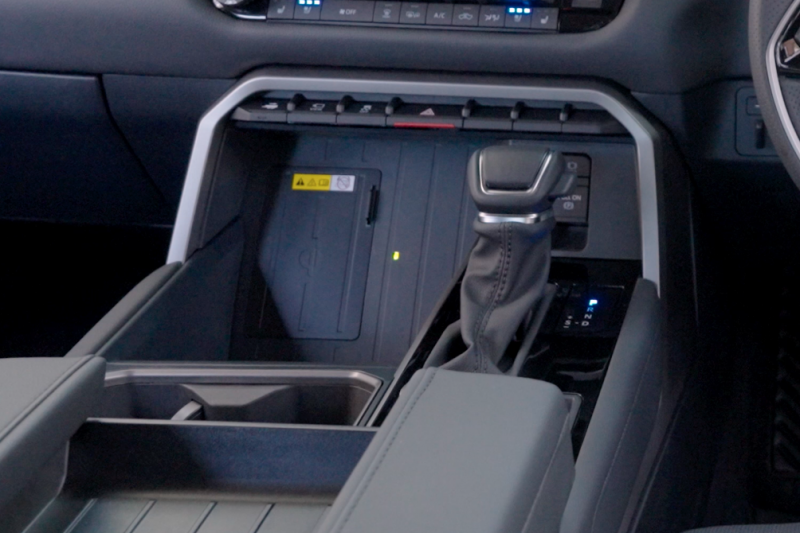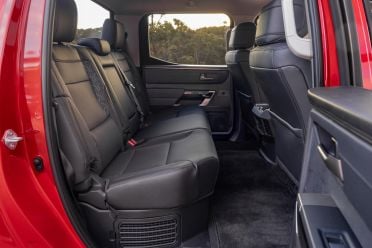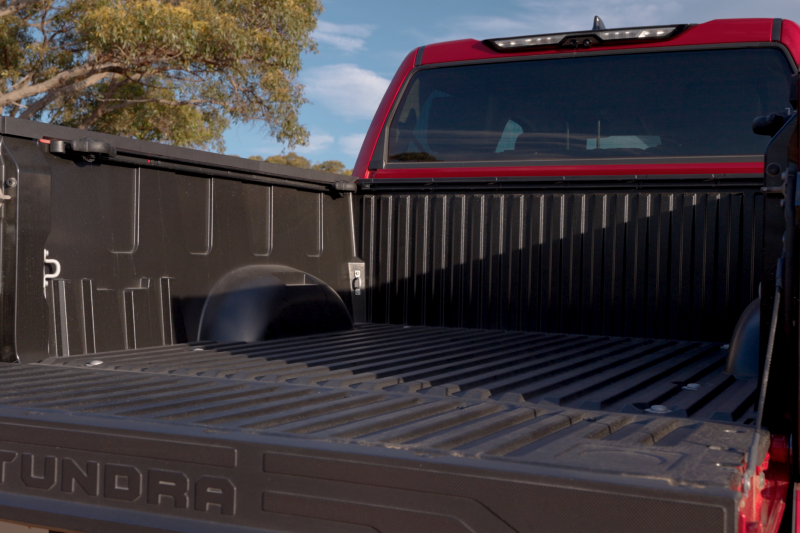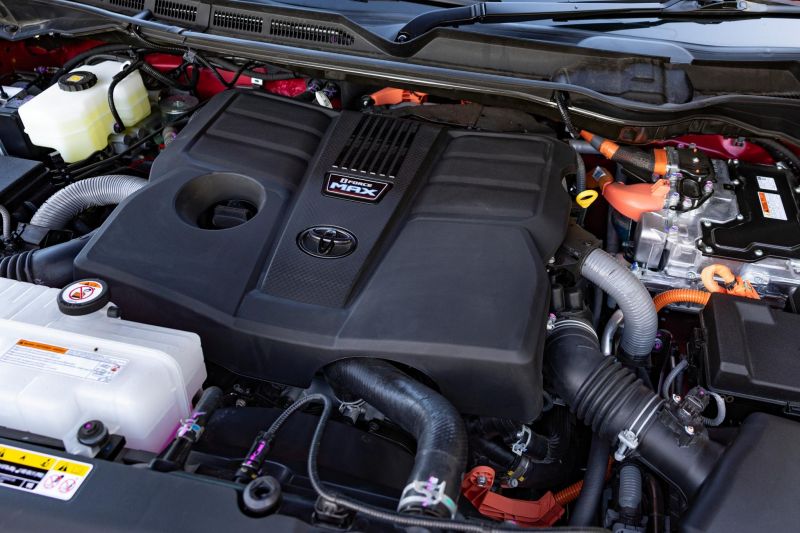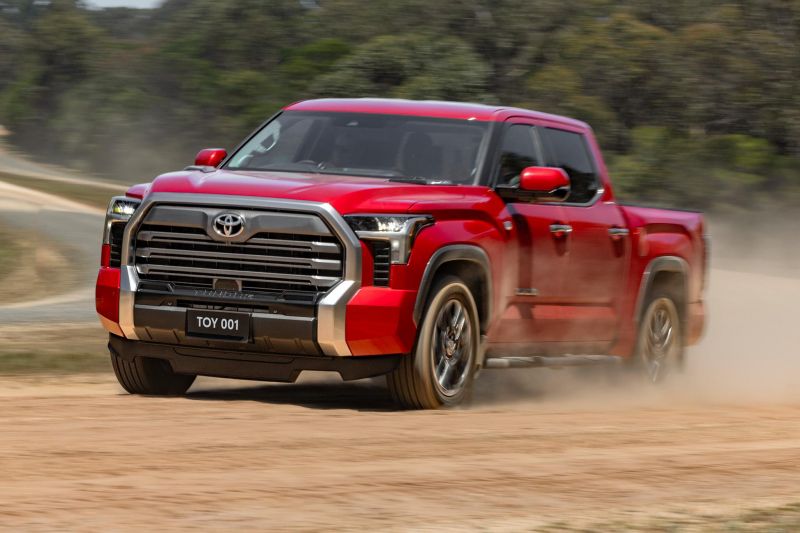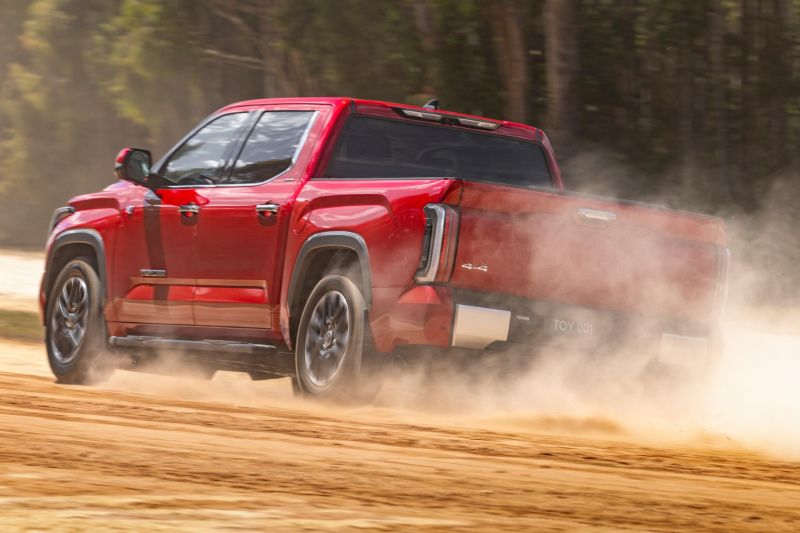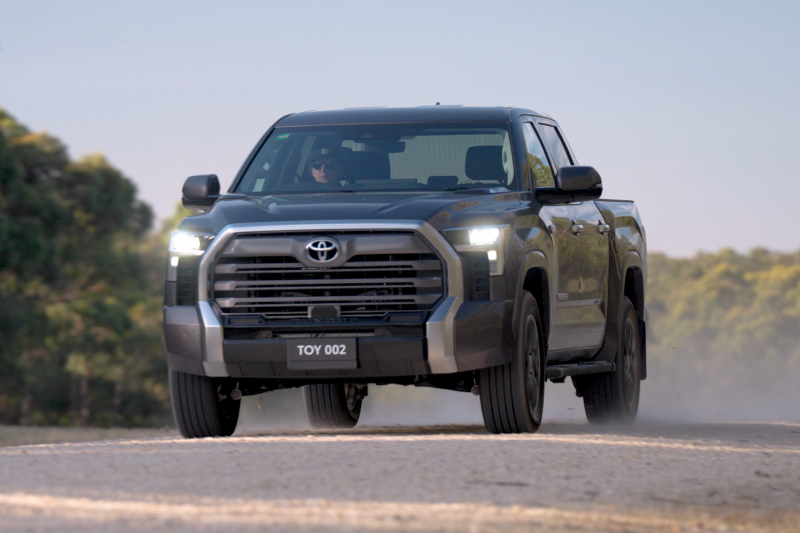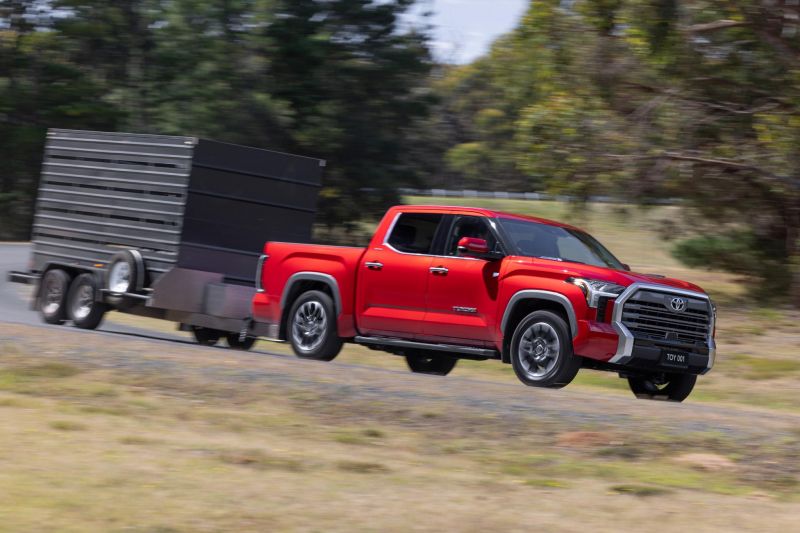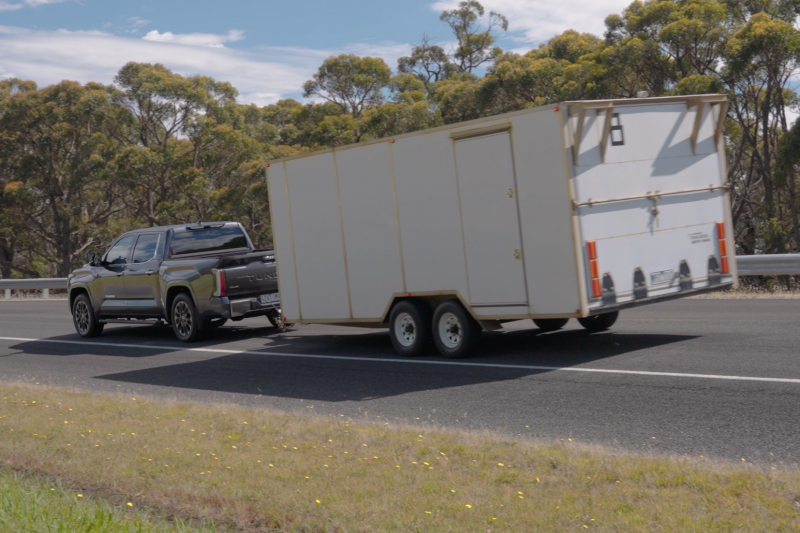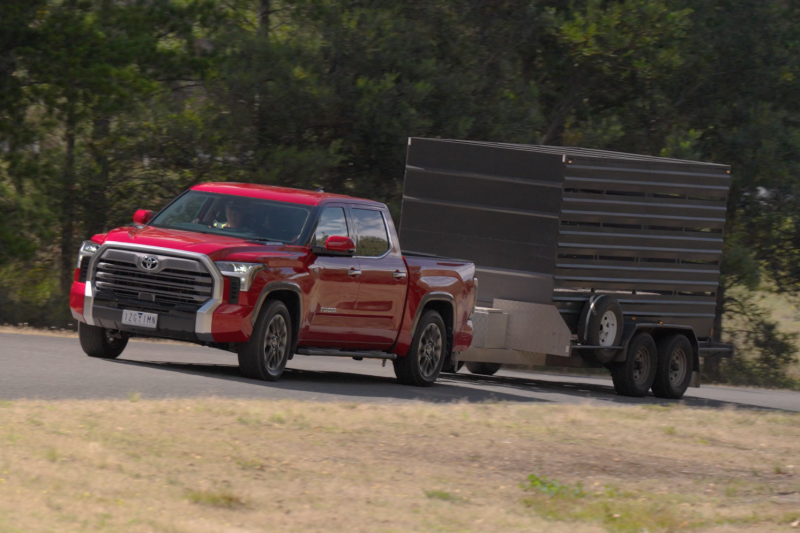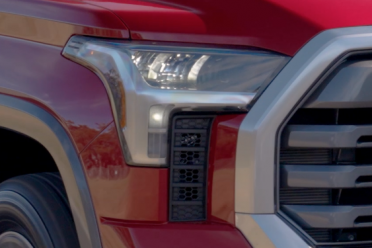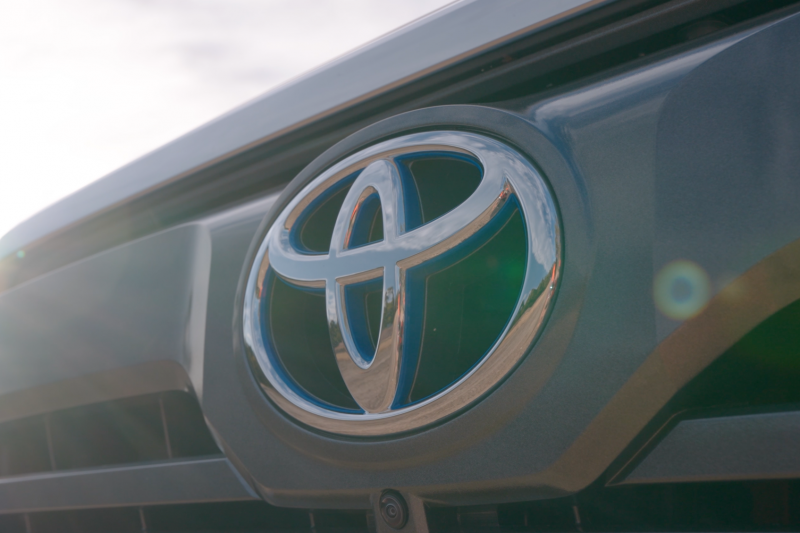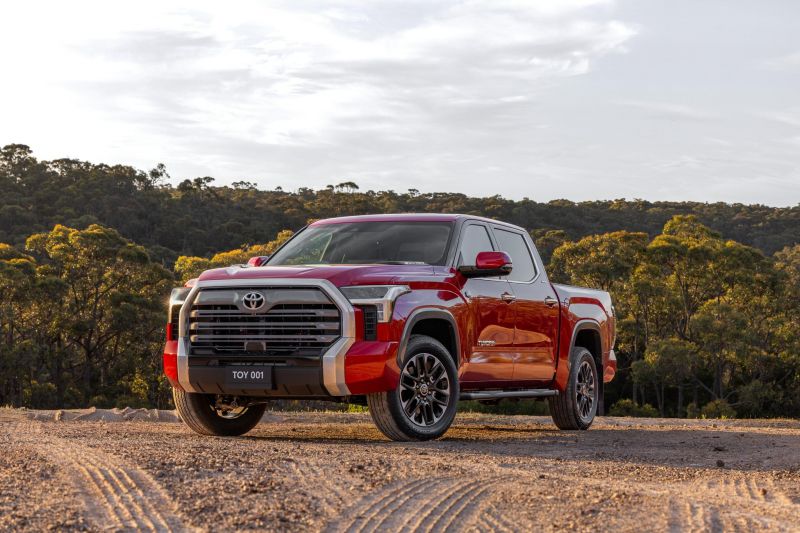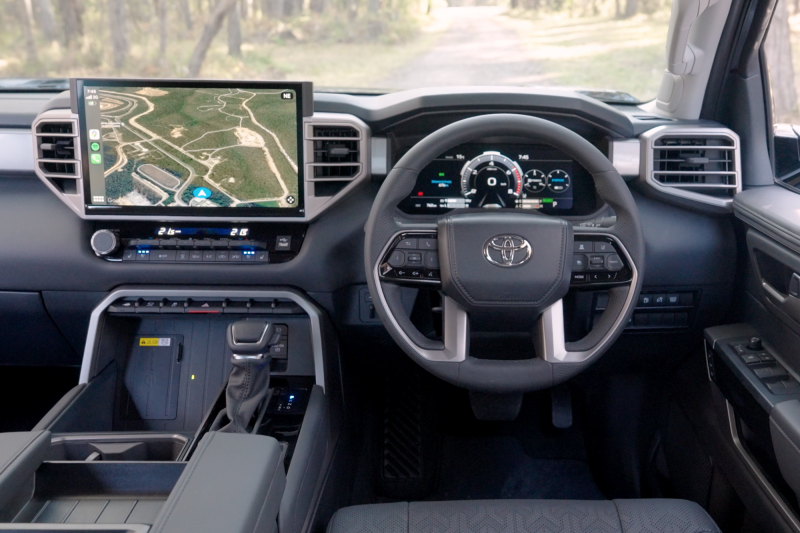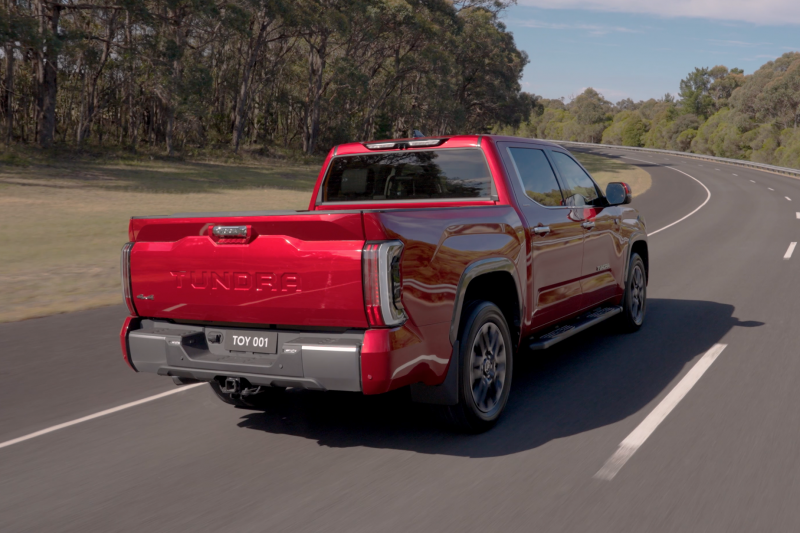The Toyota Tundra still isn’t on sale in Australia yet, though a number of customers have been selected to test it on local roads.
The so-called Tundra Insider Program sees 300 potential customers lease the Tundra as part of a “real-world evaluation and validation program”. They’re required to report back to Toyota regularly on their experience with the pickup.
This project has been in the works since 2019, and Walkinshaw Automotive Group has been enlisted to convert the 300 Tundras included in this pilot program at a facility in Dandenong, Victoria.
Deliveries of the locally converted Tundra began in late last year and are expected to be completed by April 2024.
Toyota Australia vice president of sales and marketing Sean Hanley said late last year the trial will go for a minimum of 12 months and could be extended if necessary.
“Right now we don’t officially have approval to launch this vehicle in Australia,” said Mr Hanley.
“Until we get over all the quality criteria requirements of Toyota, we can’t confirm a time when that’ll happen.
“But so, first priority, get these 290 on the road, go through the trial period, make any amendments that we have to make, recheck our quality criteria, and then determine whether we can launch.”
The only Tundra variant offered locally with this pilot program is the Limited, which is technically a mid-specification model in the US range.
Given the Ram 1500 and Chevrolet Silverado 1500 have dominated the full-size pickup segment locally for years now, and the Ford F-150 has only just arrived, how does the Toyota Tundra stack up? Read along to find out.

How much does the Toyota Tundra cost?
The 300 customers selected as part of the evaluation program are being provided with a Tundra on a “Full Service Lease” through Toyota Finance Australia.
For a single monthly payment of $2500, the lease covers all six-monthly/10,000km logbook servicing, mechanical repairs, replacement tyres, roadside assist, registration and compulsory third-party insurance.
Comprehensive insurance is also provided by Toyota Insurance.
What is the Toyota Tundra like on the inside?
Walking up to the Toyota Tundra you get the first indication this pickup is absolutely huge! It measures in at almost 6.0 metres long, 2.0 metres wide, and almost 2.0 metres tall – so it certainly has a presence.
This sense of size continues as you hop into the Tundra. It’s a fair climb into the pickup though thankfully there are side steps and hefty grab handles to make this easier.
The seats in the Tundra are black synthetic leather units that have perforations on the backrest and seat base.
The two front seats in particular have eight ways of power adjustability. This is one of the few times you realise you’re driving a vehicle that’s been converted from left- to right-hand drive as the front passenger seat’s thigh support lifts up noticeably higher than the driver’s.
The front seats also offer both heating which is handy on cold mornings, as well as ventilation which is a godsend on blisteringly hot days.
Ahead of the driver is a chunky leather-wrapped steering wheel that has perforated sections which help with regulating the temperature of your hands and stop them from getting too clammy.
The steering wheel also has a range of physical buttons and switches that have a satisfying click or push. Physical buttons are an absolute must in this sort of vehicle because drivers may be wearing gloves and not be able to use touch-sensitive buttons.
Behind the steering wheel is a 12.3-inch digital instrument cluster that offers high resolution.
The digital instrument cluster itself has a little bit of configurability with switchable information pages. There’s a central rev counter and digital speedometer always on show.
Moving across, the centrepiece of the Tundra’s interior is the massive 14.0-inch touchscreen infotainment system. It sits proud atop the dashboard and is one of the first things you see inside the pickup.
Like the digital instrument cluster, the touchscreen infotainment system is incredibly high-resolution. I only spent a limited time interacting with it, though what I did experience is it seems to have plenty of processing power, which means it boots up quickly and new pages load fast.
The touchscreen offers wireless Apple CarPlay as standard, though with Android Auto is only offered in wired form.
In terms of charging options, there are a total of five USB ports in the Tundra, one 12V accessory socket, as well as a wireless charger. The latter is located in a huge section at the front of the centre console.
Speaking of the centre console, it’s massive! There’s so much storage space on offer, especially in the central armrest.
I appreciate there’s a proper gear selector in the Tundra instead a rotary dial like in some of its competitors. Rotary dial gear selectors can be hard gauge which gear you’re in or selecting. There’s also an electronic park brake that comes on automatically once you select park.
The Tundra is equipped with an integrated trailer brake controller, which is the first time it’s been fitted as standard in a Toyota vehicle locally. It’s located just to the left of the steering wheel which is a great location so you’re not reaching too far away from the steering wheel in order to use it.
Looking around the Tundra’s interior there are plenty of soft touches. Toyota has even made a secondary door armrest up higher on the door panel for those who like to rest their arm at the window line.
There are minimal applications of glossy piano black inside the Tundra, which is really nice to see. There are few vehicles currently on sale in Australia that don’t have this finish, which gets so grimy and scratched quickly.
Hopping in to the second row of the Tundra is another time you realise just how large this pickup is. The space on offer is palatial and you almost feel disconnected from everything that’s happening in the front.
Like the front row, there are thankfully side steps and chunky grab handles to help make climbing into the second row a bit easier. Despite this, there are no overhead grab handles in the Tundra which doesn’t make sense to me.
In terms of second-row amenities, there are centre console-mounted directional air vents, USB ports, and a fold-down armrest with cupholders.
The second row is also home to one of my favourite feature on the Tundra – the sliding rear window. Unlike a number of other pickups with similar sliding windows, the Tundra’s entire rear window goes up and down. This is such a handy feature to have if you want to let some hot air out.
At the back of the Tundra there’s a dampened tailgate which thankfully makes opening and closing it easier. Once you open the tailgate you’re presented with a huge tub area.
The Tundra’s tub measures in at 1666mm long, 1490mm wide (1237mm between the arches), and 530mm tall. Despite the hefty dimensions, the Tundra only has a payload of 758kg which isn’t as good as smaller dual-cab utes like the HiLux.
Overall, it’s really hard to tell the Tundra has been converted from left- to right-hand drive locally. Walkinshaw, along with Toyota, has done a great job at concealing this fact on the inside.
What’s under the bonnet?
| Model | Toyota Tundra i-Force Max |
|---|---|
| Engine | 3.4-litre twin-turbo V6 petrol engine |
| Engine power | 290kW |
| Engine torque | 650Nm |
| Electric motor power | 36kW |
| Electric motor torque | 250Nm |
| Total system power | 326kW |
| Total system torque | 790Nm |
| Battery | 6.5Ah nickel metal hydride |
| Transmission | 10-speed automatic transmission |
| Driven Wheels | Part-time four-wheel drive |
| Weight | 2778kg (kerb) |
| Payload | 758kg |
| Braked towing capacity | 4500kg |
| Gross vehicle mass (GVM) | 3546kg |
| Gross combination mass (GCM) | 7825kg |
| Ground clearance | 216mm |
| Approach angle | 23 degrees |
| Departure angle | 21 degrees |
| Fuel economy (claimed) | 12.4 litres per 100km (EPA) |
| Fuel economy (as tested unladen) | 16 litres per 100km |
| Fuel economy (as tested with 4.5T trailer) | 35 litres per 100km |
| Fuel tank | 122 litres |
| Minimum fuel requirement | 95 RON |
To see how the Tundra compares to its rivals, line it up side-by-side with any car you want using our comparison tool.
How does the Toyota Tundra drive?
It’s worth flagging straight away this media drive of the locally converted Toyota Tundra was on controlled roads at a testing ground. I was able to experience the Tundra unladen on both sealed and unsealed surfaces, as well as while towing 3.5-tonne and 4.5-tonne trailers on short drive loops.
We’ll withhold full judgement on the Toyota Tundra until we can experience it properly on public roads.
Starting up the Toyota Tundra with its i-Force Max hybrid engine is a largely silent affair, as it predominantly starts up in EV mode. This is strange given the vehicle is such a large pickup and capable of towing so much.
The pickup is capable of driving around at low speeds on EV mode, which feels so bizarre, though like a number of other Toyota hybrids with less sophisticated nickel-metal hydride battery packs, it doesn’t take much for the engine to fire up.
With the Tundra in particular you only need to give it a whiff of the accelerator and the engine turns on. There are also ‘Tow’ and ‘Tow+’ drive modes that keep the engine constantly switched on to ensure peak power and torque can be delivered instantaneously and at all times.
Behind the wheel you don’t feel when the 3.4-litre twin-turbo V6 petrol engine switches on, though you can definitely hear it. The engine has a pleasant note and almost purrs at idle.
With the assistance of the electric motor-generator, the Tundra i-Force Max is far from slow. It produces total system outputs of 326kW and 790Nm, which gets the almost 2.8-tonne pickup moving along at a brisk pace if asked.
This generation of Toyota Tundra isn’t available with a V8 engine of any variety globally, though the way this i-Force Max hybrid engine delivers power makes me not really miss the option at all. I also love the sweet turbo noises the twin-turbo V6 petrol engine makes when pushed.
Behind the wheel you’re able to see just how much electrical assistance is being provided when driving, along with how hard the turbo is working.
Another benefit of the electrical assistance is the V6 petrol engine’s revs are able to kept down and within its torque band. This makes the Tundra feel like an effortless tourer and cruiser.
Something to note however, is the Tundra only comes with a part-time four-wheel drive system that has a shift-on-the-fly function. This means the pickup can’t be in four-wheel drive on sealed surfaces. In some circumstances the Tundra can get some wheel slip if you punch it.
At low speeds the Tundra has light steering which makes it feel smaller than it really is. Despite this there’s no way to escape just how large it is, especially when you do a U-turn or attempt a tight park for example.
The Toyota Tundra has double wishbone front and multi-link rear suspension. The latter is geared more heavily towards on-road comfort rather than load carrying.
The rear multi-link suspension is part of the reason why the Tundra has a lower payload figure than smaller dual-cab utes with leaf suspension.
Toyota chose the retain the Tundra’s North American suspension tune for the locally converted version, with Toyota Australia senior manager of vehicle evaluation and regulations Ray Munday saying “there was no need to change that”.
Even though the Tundra has a North American suspension tune, it floated and soaked up every single bump both on- and off-road at the proving ground. The pickup does get a bit of a roll up, which does make sense though given its almost 2.8-tonne kerb weight.
It would be very interesting to see how the Tundra fares on rougher and more unforgiving roads outside the proving ground. As noted above, I got to experience the towing a 3.5-tonne trailer, as well as a 4.5-tonne trailer with the Tundra.
The pickup comes with software that helps make connecting a trailer as easy as possible. You can even tell the Tundra how big and heavy the trailer is.
When towing both trailers with the Tundra, it really didn’t feel like there was anything on the back. The pickup felt rock solid.
One of the few ways to tell there was something on the back however was the acceleration was just a bit slower and it took longer to slow down.
I thought the Tundra’s hybrid system would help keep fuel economy down during towing, but boy was I wrong. I averaged an eye-watering 35 litres per 100km during the short test loops when towing both the 3.5-tonne and 4.5-tonne trailers.
Thankfully things did get a little better in terms of fuel economy when the Tundra wasn’t towing. I averaged around 16 litres per 100km on the short driving loops conducted throughout the media drive.
This is a closer to the US-specification Tundra’s claimed combined fuel consumption figure of 12.4 litres per 100km according to EPA testing standards.
Given the main purpose of the Tundra is towing however, be prepared for a hefty fuel bill. You’re also required to top it up with a minimum of 95 RON premium unleaded petrol.
The drive loops for the Tundra were quite short, so I didn’t get a proper chance to test out how its safety systems were. What I did notice however is the lane-keep assist system is helpful enough and isn’t too intrusive like some systems can be.
What do you get?
Tundra Limited highlights:
- 20-inch alloy wheels
- Automatic LED headlights
- Automatic high-beam
- Heated, power-folding side mirrors
- incl. reverse tilt-down function
- Active front spoiler
- Tub management system
- Side and back rails
- Moveable tie-down points
- 12-pin trailer wiring harness
- 50mm tow ball (3500kg rated)
- 12.3-inch digital instrument cluster
- 14.0-inch touchscreen infotainment system
- Wireless Apple CarPlay
- Wired Android Auto
- DAB+ digital radio
- 12-speaker sound system
- Wireless phone charger
- Dual-zone climate control
- Proximity entry, push-button start
- Five USB ports
- 12V outlet
- Front and rear carpet floor mats
- Leather-accented steering wheel
- Black synthetic leather upholstery
- Heated and ventilated front seats
- 8-way power adjustable front seats
A 70mm tow ball is optional and enables the Tundra to able tow a 4500kg braked trailer. There are also a range of genuine accessories ranging from a tonneau cover, load distribution hitch, and all-weather floor mats.
Is the Toyota Tundra safe?
The Toyota Tundra hasn’t been crash-tested by ANCAP or Euro NCAP at this stage. In the US however it was awarded a Top Safety Pick+ rating by the Insurance Institute for Highway Safety (IIHS).
Standard safety equipment includes:
- 8 airbags
- Autonomous emergency braking (AEB)
- Pedestrian, Cyclist detection (day, night)
- Blind-spot monitoring
- Rear cross-traffic alert
- Lane departure alert
- Lane Trace Assist
- Emergency steering assist
- Adaptive cruise control
- Surround-view cameras
- Front, rear parking sensors
How much does the Toyota Tundra cost to run?
As part of the lease agreement for the 300 Tundras included in this evaluation program, all mechanical repairs, servicing, replacement tyres, and roadside assist is covered.
Logbook servicing is required every six months or 10,000km, whichever comes first.
CarExpert’s Take on the Toyota Tundra
The Toyota Tundra is considerably later to the party than a number of its full-size pickup rivals. It’s also not even for retail sale yet, and won’t be at least for another 12 months.
The full-size pickup market is still on the rise in Australia, with the segment growing over 20 per cent year-on-year according to the latest VFACTS sales figures. This segment has been virtually monopolised by the Ram 1500 and Chevrolet Silverado to date.
It’s classic Toyota to have the rollout of the locally converted Tundra be very measured and deliberate, and I can clearly understand why the company is doing this in order to ensure both the product and conversion process are rock solid.
But to have the rollout of the right-hand drive Tundra be so drawn out and public is such a tease. The Toyota Tundra i-Force Max is an epic towing machine with plenty of power to boot, and the 3.4-litre i-Force Max hybrid powertrain will make you say “V8 who?”
Despite this, I thought the Tundra’s hybrid components would help reduce fuel economy more than it did.
An average of 35 litres per 100km when towing a 4.5-tonne trailer will certain chew into your pocket quickly when you’re filling up with 95 RON premium unleaded petrol.
The last thing I’ll mention is the fact the Tundra, like all its full-size pickup rivals, is absolutely massive both inside and out. This isn’t the kind of vehicle that will fit down tight urban alleyways or carparks easily, but will feel much more suited to the open road.
Come on Toyota, give us the Tundra already!
Click the images for the full gallery
MORE: Everything Toyota Tundra

